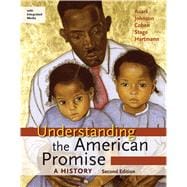Understanding the American Promise, Second Edition, features a brief, question-driven narrative that models for students the inquiry-based methods used by historians and features innovative active learning pedagogy to help students understand what’s really important to know about U.S. history. This affordable text comes integrated with LearningCurve, an adaptive learning tool that helps students retain what they’ve read and come to class prepared.
What's in the LaunchPad








